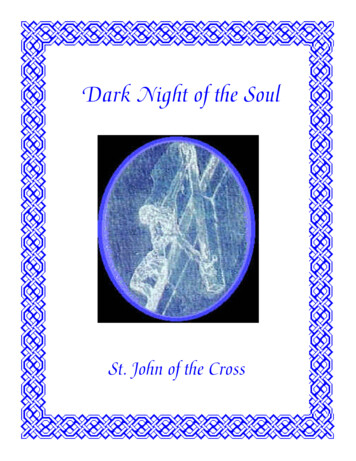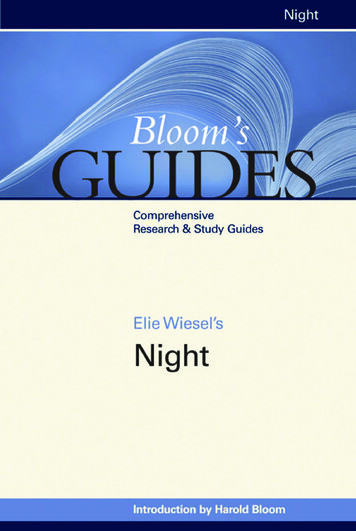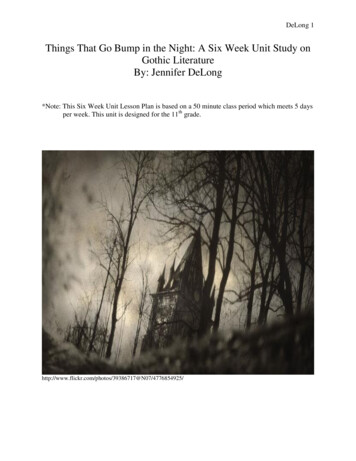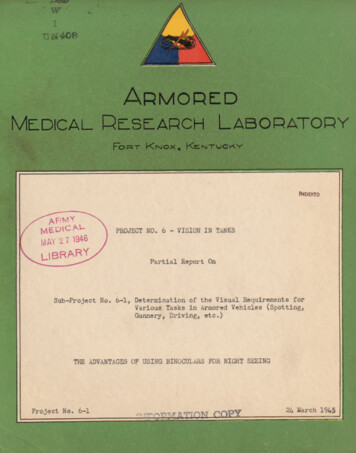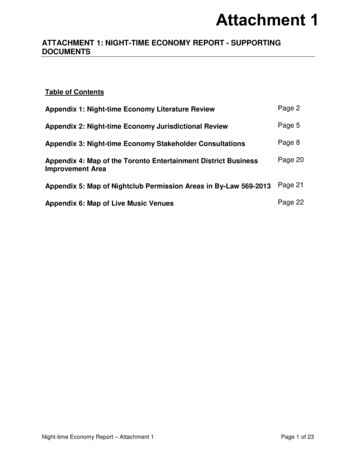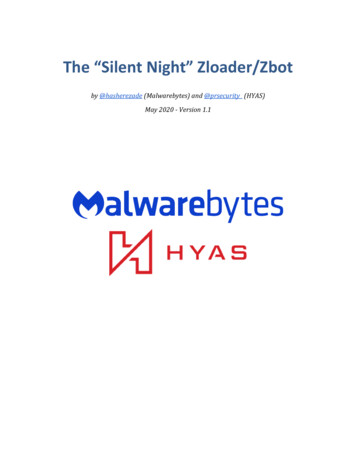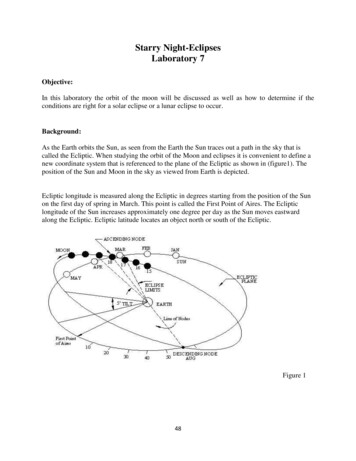
Transcription
Starry Night-EclipsesLaboratory 7Objective:In this laboratory the orbit of the moon will be discussed as well as how to determine if theconditions are right for a solar eclipse or a lunar eclipse to occur.Background:As the Earth orbits the Sun, as seen from the Earth the Sun traces out a path in the sky that iscalled the Ecliptic. When studying the orbit of the Moon and eclipses it is convenient to define anew coordinate system that is referenced to the plane of the Ecliptic as shown in (figure1). Theposition of the Sun and Moon in the sky as viewed from Earth is depicted.Ecliptic longitude is measured along the Ecliptic in degrees starting from the position of the Sunon the first day of spring in March. This point is called the First Point of Aires. The Eclipticlongitude of the Sun increases approximately one degree per day as the Sun moves eastwardalong the Ecliptic. Ecliptic latitude locates an object north or south of the Ecliptic.Figure 148
EclipsesThe Moon orbits the Earth in a plane that is inclined to the plane of the Ecliptic at an angle ofapproximately 5 degrees, as depicted in (figure 1). When the Moon has the same Eclipticlongitude as the Sun it is called a New Moon. When the Moon has an Ecliptic longitude greaterthan the Sun’s by 180 degrees we call it a Full Moon. It takes approximately 29 ½ days for theMoon to go through all its phases and become a New Moon again. Twice every lunar orbit theMoon crosses the Ecliptic. These two points are known as the Ascending Node and DescendingNode.Both the Earth and the Moon cast shadows into space. When the shadow of the Moon falls ontothe Earth a Solar Eclipse occurs. When the shadow of the Earth falls onto the Moon a LunarEclipse occurs. For a Solar Eclipse to occur, the Moon must cross the Ecliptic within 18.5degrees of the Sun’s current Ecliptic longitude at New Moon. This region that guarantees anEclipse is called the Eclipse Limits as shown in (Figure 1). Every six months the Moon crossesthe Ecliptic within the Eclipse Limits and an eclipse occurs.An interesting property of eclipses is that nearly identical eclipse occurs every 18 years 11 daysand 8 hours. This occurs because the line of nodes rotates in a westward direction taking 18 yearsto complete a full rotation. In the example discussed later eclipses will occur in Feb and July dueto the rotation of the line of nodes.The Moons OrbitWhen a Satellite orbits the Earth the orbit will be an ellipse (Figure 2). An ellipse has theproperty that the sum of the distance of the orbiting body from the two foci of the ellipse is aconstant. The Earth is located at one foci as shown in figure 2. The point of closest approach iscalled perigee (Pe), and the point of furthest distance is called apogee (Ap).Eccentricity measures how elongated an orbit is. The higher the eccentricity the more elongatedthe ellipse. A circle has an eccentricity of zero.The eccentricity can be calculated from the Apogee and Perigee distance of the orbiting bodywith the following formula;49
Figure 2Figure 3As the Moon orbits the Earth its distance from the Earth changes, and so does its observedangular size. The pictures in Figure 3 were taken with the same telescope with the samemagnification on different dates. The change in angular diameter of the Moon is quite obvious.The change in Angular size is directly proportional to the distance of the Moon. If the Moon wastwice as close to the Earth it would appear twice as big in the sky.50
Instructions:Over the period of a simulated month, we will look at the position of the Moon using the StarryNight software. The distance away will be used to calculate the eccentricity of the Moon’s orbit.We will also measure the Ecliptic longitude and Ecliptic latitude of the Moon for eachobservation and use it to tell us whether the Moon is above or below the plane of the Ecliptic.From this we can find the Ecliptic longitude of both the Ascending and Descending node. Wewill then find the dates for the eclipse seasons.Open Starry Night and be sure your location is set L.A., Ca.Begin by setting the date to January 1, 2017 and the time to 11:00 a.m.Open Options located in the tabs on the left of your screen and expand Guides by clicking theplus sign next to it. Within this field expand Ecliptic Guides by clicking the plus sign next to it.Within this field check the box labeled The Ecliptic.In the toolbar, open View and select Hide Daylight to aid in seeing the Moon during the day.51
Open Find located in the tabs on the left of your screen. Within this field check the box labeledSun and the Moon. Also check the orbit checkbox to the right of the moon.Your screen should look something like thisNow open Info located in the tabs on the left of your screen. Expand Position in Sky andPosition in Space by clicking the plus sign next to each. Within these three fields we will get allof our data; Ecliptic longitude, Ecliptic latitude, Distance from Observer.Your screen should look something like this52
For each day record the missing data into the table in your answer sheet and answer the questionsthat follow. All data should be taken at the times given.Date in 2017Ecliptic LongitudeEcliptic LatitudeDistance fromObserverJan 1 at 11 a.m.Jan 4 at 3 p.m.Jan 7 at 3 p.m.Jan 10 at 7 p.m.Jan 13 at 10 p.m.Jan 16 at 2 a.m.Jan 19 at 2 a.m.Jan 22 at 5 a.m.Jan 25 at 9 a.m.Jan 27 at 9 a.m.Also look at August 21, 2017 at 9 a.m. What do you see?ECLIPSE SEASONSOn the ecliptic graph paper provided, plot the Ecliptic Longitude and Ecliptic Latitude of theMoon for each day in the table. Draw a smooth curve connecting the points. Find the nodes ofthe Moon’s orbit (the points where the Moon’s path crosses the ecliptic) and note the EclipticLongitude of each node.Now estimate the days on which the Sun will be located at one of the nodes. To do this estimateeach month having 30 days and the Sun increasing its ecliptic longitude by one degree each day.So take the ecliptic longitude of the node and divide by 30 noting the remainder. The number isthe number of months past March 21 and the remainder is the number of days following.For example, if a node is located at an ecliptic longitude of 135 , we first divide by 30 and get ananswer of 4.5, which is 4 with a remainder of 15 (do the division long hand). This means thatthe Sun will be located at this node 4 months and 15 days after March 21. The four months get usto July 21. Then add 15 days to get the date of August 6.1. What is the approximate ecliptic longitude of the Moon at the Ascending Node?2. What is the approximate ecliptic longitude of the Moon at the Descending Node?3. Using the above procedure, estimate when the Sun will next be located at each of the nodes;Ascending Node Date-Descending Node Date-53
Answer Sheet-Lab 7Date in 2017Ecliptic LongitudeName-Ecliptic LatitudeDistance fromObserverJan 1 at 11 a.m.Jan 4 at 3 p.m.Jan 7 at 3 p.m.Jan 10 at 7 p.m.Jan 13 at 10 p.m.Jan 16 at 2 a.m.Jan 19 at 2 a.m.Jan 22 at 5 a.m.Jan 25 at 9 a.m.Jan 27 at 9 a.m.On August 21, 2017 at 9 a.m. What do you see?1. What is the approximate ecliptic longitude of the Moon at the Ascending Node?2. What is the approximate ecliptic longitude of the Moon at the Descending Node?3. Using the above procedure, estimate when the Sun will next be located at each of the nodes;Ascending Node Date-Descending Node Date-4. How many days off was your closest possible eclipse date to the actual Solar eclipse onAugust 21, 2017?5. From your data, which distance must be nearest the apogee distance of theMoon?6. From your data, which distance must be nearest the perigee distance of theMoon?7. Using your answers from #4 and #5, calculate the eccentricity of the Moon’sorbit.54
ECL 6 5 4 IPT 3 2 IC 1 E0 CLIPTICLAT–1 –2 ITU–3 –4 DE–5 0 EC60 LIP120 IT180 C55LO240 NGI300 TUDE
the Earth a Solar Eclipse occurs. When the shadow of the Earth falls onto the Moon a Lunar Eclipse occurs. For a Solar Eclipse to occur, the Moon must cross the Ecliptic within 18.5 degrees of the Sun’s current Ecliptic longitude at New Moon. This region that guarantees an Eclipse is called th



